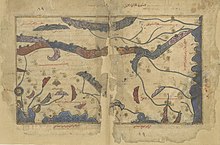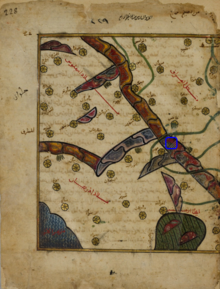
Back نزهة المشتاق في اختراق الآفاق Arabic Tabula rogeriana Catalan Tabula Rogeriana Czech Tabula Rogeriana German Kitab Ruyar Spanish Tabula Rogeriana Basque نزهة المشتاق فی اختراق الآفاق Persian Tabula Rogeriana Finnish Tabula Rogeriana French Kitāb Rūŷar Galician
 Map of al-Maghrib al-Aqsa and al-Maghrib al-Awsat (south-up) in MS arabe 2221, the oldest known surviving manuscript copy of Idrisi's Tabula Rogeriana. | |
| Author | Muhammad al-Idrisi |
|---|---|
| Media type | Atlas |
The Nuzhat al-mushtāq fī ikhtirāq al-āfāq (Arabic: نزهة المشتاق في اختراق الآفاق, lit. "The Excursion of One Eager to Penetrate the Distant Horizons"), commonly known in the West as the Tabula Rogeriana (lit. "The Book of Roger" in Latin), is an atlas commissioned by the Norman King Roger II in 1138 and completed by the Arab geographer Muhammad al-Idrisi in 1154. The atlas compiles 70 maps of the known world with associated descriptions and commentary of each specific location by Al-Idrisi.[1][2][3][4]

- ^ Houben, 2002, pp. 102–104.
- ^ Ahmad, 1992, pp. 156–161.
- ^ Al-Fora, Uthman (1983). "Al-Sharif Al-Idrisi and His Contributions to Geography" (PDF). King Saud University, Journal of the College of Education. 5: 159–185 – via King Saud University.
- ^ Editorial Board of Aljaranda (March 2016). "Travelers in Tarifa". Aljaranda. 89: 95–98 – via Dialnet.